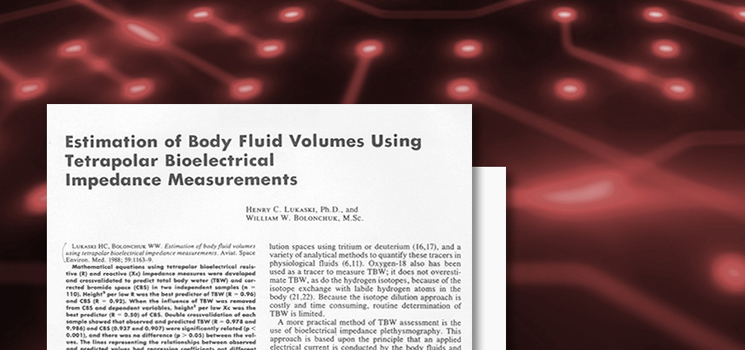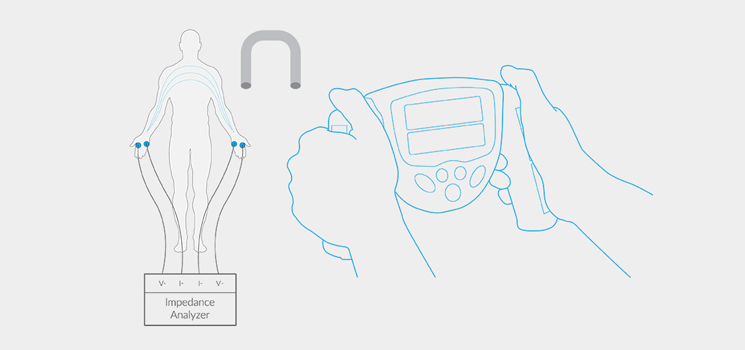What is BIA?
InBody utilizes Bioelectrical Impedance Analysis (BIA) technology to measure human body composition. BIA is a technology that quantitatively measures body composition through impedance that occurs when an electric current flows through the human body.
BIA, which was first used in the late 1960's, is a method of measuring body water by sending an alternating current through the human body and obtaining an impedance index based on the fact that the human body is made of water that conducts electricity well and the resistance varies depending on the amount of water.
Until the late 1980s, the BIA method was a whole-body impedance measurement method with single low frequency. This method gave inaccurate results so the results had to be compensated through empirical estimation. However, the formulas with empirical estimation was only accurate for those within the study group, and those outside of the group had a low accuracy.
Therefore the formula could not be used universally and was not developed for clinical use in hospitals.
Nevertheless, technological limitations for measuring bioelectric impedance were overcome and fundamental BIA technology were developed. Leading to development of the multi-frequency and segmental impedance measurement, Body composition analysis was able to become more precise without using empirical estimations and by only using impedance.
Fundamental Principles of BIA
BIA is used in various fields with its high precision, convenience, and economic feasibility, but it is necessary to carefully review the differences in measurement technology for clinical use.
For BIA user, it is important to fully understand the measurement principles of BIA to minimize the biological and environmental factors that affect the results. Also needs to understand the resistance and reactance or how impedance is measured.
Read Detail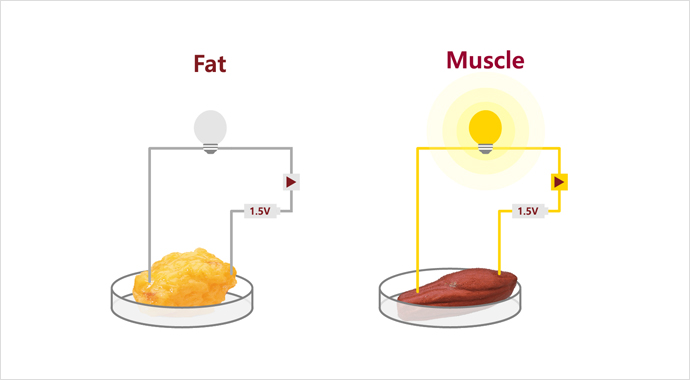
The History of BIA Technology
BIA, which was first used in the late 1960's, is a method of measuring body water by sending an alternating current through the human body and obtaining an impedance index based on the fact that the human body is made of water that conducts electricity well and the resistance varies depending on the amount of water.
Until the late 1980s, the BIA method was a whole-body impedance measurement method with single low frequency. This method gave inaccurate results so the results had to be compensated through empirical estimation. However, the formulas with empirical estimation was only accurate for those within the study group, and those outside of the group had a low accuracy. Therefore the formula could not be used universally and was not developed for clinical use in hospitals.
- 1969
- Dr.Hoffer and the Impedance Index
- 1979
- RJL Systems and the first impedance meter
- 1992
- Kushner and the Proposal of Multi-frequencies with Segmental Analysis
- 1996
- Dr. Cha creates the InBody Body Composition Analyzer
- 2020
- The World’s first 3MHz high-frequency
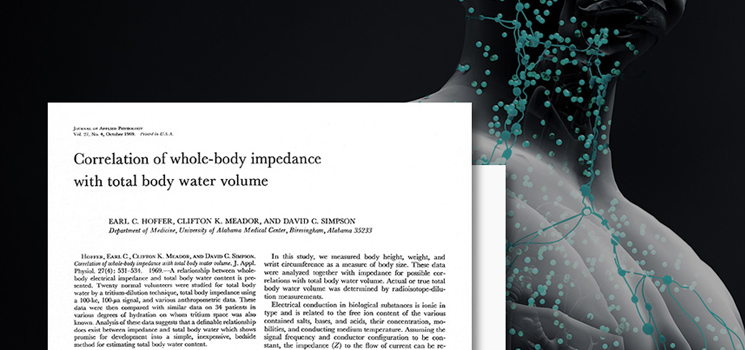
Dr.Hoffer and the Impedance Index
In 1969, Hoffer carried out a series of experiments to prove that total body water and biological impedance were highly correlated, suggesting that impedance measurement could be used for determining total body water. He showed the squared value of height divided by impedance was highly correlated with total body water.
Hoffer took impedance measurements of the right half of the body including the right arm, torso, and right leg. The squared value divided by impedance showed correlation coefficient of 0.92 with total body water, which was higher than other indices including body weight. The equation Hoffer proved is the impedance index used in BIA today.
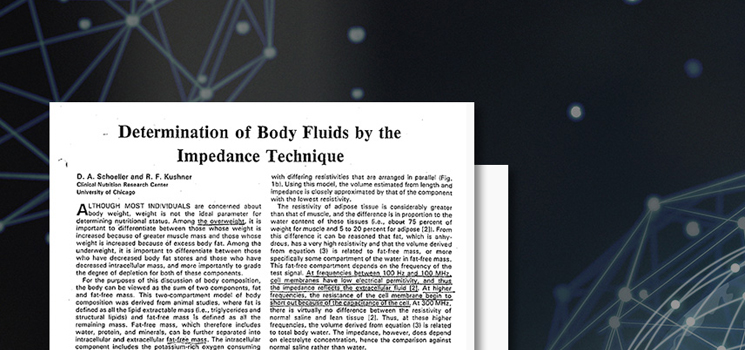
RJL Systems and the first impedance meter
In 1979, RJL Systems commercialized the impedance meter for the first time and the BIA method began to gain popularity. The device measured impedance by attaching electrodes on the back of the right hand and a top of the right foot of a patient and conducting a current of 50kHz through the right half of the body.
Prior to this, body composition could only be measured by caliper or underwater weighing. Such methods needed to be carried out by skilled people and installation was not easy. Also, only specific types of patients could benefit from them. BIA however, was easy, fast, less expensive and less intrusive. Therefore, many body composition researchers, nutritionists, and medical experts began to use BIA.
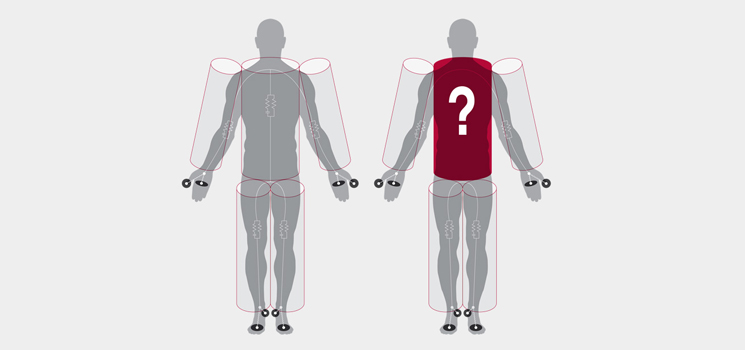
Kushner and the Proposal of Multi-frequencies with Segmental Analysis
Since the inaccuracy of BIA is due to technical limitations, many argued that this could be improved upon. In 1992, Kushner claimed that the human body is made up of five cylinders (right arm, left arm, torso, right leg, left leg) instead of one.
While the thin limbs affect the total impedance, the torso, which has the largest cross-sectional area, has little impact on impedance. However, since the torso makes up 50% of lean body mass, Kushner emphasized that measuring the impedance of the body torso separately would be very important. Measuring the total impedance alone would not be sufficient but all five parts must be measured separately at different frequencies, making a distinction between extracellular water and intracellular water. In other words, the technical limitations of BIA should be overcome by measuring different parts at different frequencies.
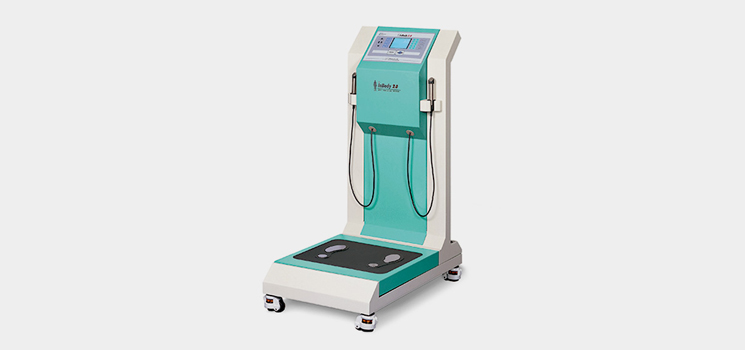
Dr. Cha creates the InBody
Body Composition Analyzer
In 1996, Dr. Kichul Cha developed InBody, the world’s first 8-point tactile electrode system with direct segmental analysis to measure impedance in the five different body cylinders using multiple frequencies.
By doing so, the impedance in the limbs and torso were measured separately, yielding highly accurate results without using empirical data based on factors like age, gender, ethnicity, athleticism, and body shape. Thus, the InBody DSM-MFBIA body composition analyzer is a precision medical device. Many BIA products today provide segmental measures of muscle and fat mass, but most of these products are still unable to take segmental impedance measurements, particularly in the torso. The InBody measure each segment separately and shows the impedance values of all five cylinders of the body at each frequency in the Impedance Section of the InBody Result Sheet.

The World’s first 3MHz high-frequency
The higher the frequency, the more difficult it is to control the frequency in the human body which results in an unstable impedance measurement. InBody overcame this limitation and applied the world’s first 3MHz frequency which penetrates through our cell membranes even better, and this enables us to differentiate the Intracellular Water, Extracellular Water which helps us to get a more accurate measurement of the Total Body Water.
The Evolution of BIA through InBody
InBody overcome the limitation of conventional BIA method with technological developments. In 1996, Dr. Cha developed and commercialized ‘the world's first BIA body composition analyzer InBody that implemented direct segmental measurement and multi-frequency measurement.’ With the high precision and ease of use, BIA technology is widely recognized by the experts around the world, and hundreds of research papers based on InBody are published annually in nutrition, sports and medical fields.
You may compare the limitations of conventional BIA with InBody.
-
BIA Tech Problem : Single Frequency
In the past, BIA device only used a single frequency of 50kHz to measure the impedance. However, since 50kHz cannot penetrate through the cell membrane well, it was difficult to get accurate measurement of the water within the cell and total body water of the body. This often led to inaccurate body composition measurements in elderly or patients with water imbalance.
InBody Solution : Multiple Frequencies
InBody utilizes a wide range of multi frequency from 1kHz to 3MHz for accurate body water measurement, and identifies intra and extracellular water for precise total body water.
-
BIA Tech Problem : Low reproducibility
Since BIA interprets body composition from the impedance, high reproducibility of the measured impedance is very important to compare the changes in body composition properly. However, conventional BIA devices used the electrode that had to be attached to the measurement area. This resulted in a low reproducibility as measurement area kept changing and the impedance measurement was also different.
InBody Solution : 8-Point Tactile Electrode System
InBody applied the 8-point tactile electrodes with thumb electrodes. Current and voltage electrodes are placed in each foot and hand, to ensure the user is grasping or stepping on each electrodes. This method enables stable results by making the measurement start at the same points of the wrists and the ankles even with the change of measurement posture and multiple measurements.
-
BIA Tech Problem : Human body as one cylinder
Conventional BIA devices considered the human body as a single cylinder and measured the whole body impedance. However, each of our body segments is different in length and cross-section area. Arms and legs have a narrow area and long length, so the impedance value is high, but the muscle mass is low. On the other hand, the trunk has a relatively large area, so its impedance value is low and the muscle mass is high. Therefore, a small change in the impedance value in the trunk has a greater impact on the amount of muscle mass, so it must be measured separately in order to measure the total muscle mass accurately. If trunk is not measured separately, a large error may occur in the measurement of the total body water.
InBody Solution : Direct Segmental Measurements
InBody assumes the human body as five different cylinders and separately measures the impedance of each body segments. Therefore, InBody is able to provide more accurate body composition from measuring each part according to the body type.
-
BIA Tech Problem : Empirical estimations
Conventional BIA technology only measured the whole body impedance and could not provide the trunk impedance. Furthermore, they could not differentiate the extracellular water and intracellular water separately since they used the single low frequency. This resulted in not being able to identify the imbalance between extracellular water and intracellular water.
To adjust these limitations, empirical estimations such as age and gender were used to calculate and generalize the body composition measurement results.InBody Solution : No Empirical Estimations
Since InBody does not use empirical estimation and impedance is measured directly and independently, it will show the same result for the subject with the same body composition regardless of gender and age.
InBody Technology
-
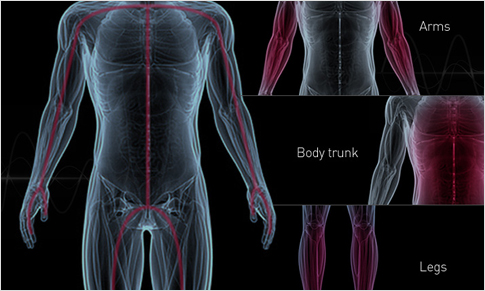 Our body and more specifically the segments of our body is different in length, and cross-section area. Arms and legs have a narrow area and long length, so the impedance value is high, but the muscle mass is low. On the other hand, the trunk has a relatively large area, so its impedance value is low and the muscle mass is high. Therefore, a small change in the impedance value in the trunk has a greater impact on the muscle mass, so it must be measured separately in order to know the accurate total muscle mass. InBody measures arms, legs, and trunk separately to provide more accurate test results.
Our body and more specifically the segments of our body is different in length, and cross-section area. Arms and legs have a narrow area and long length, so the impedance value is high, but the muscle mass is low. On the other hand, the trunk has a relatively large area, so its impedance value is low and the muscle mass is high. Therefore, a small change in the impedance value in the trunk has a greater impact on the muscle mass, so it must be measured separately in order to know the accurate total muscle mass. InBody measures arms, legs, and trunk separately to provide more accurate test results. -
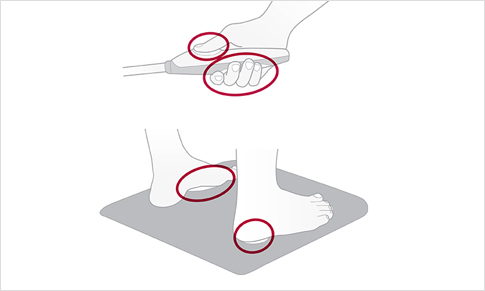 Taking the anatomical structure of the human body in consideratio, InBody placed a total of eight electrodes- one current and one voltage electrode on each handle and feet. With this electrode design, we are able to maintain the measurement starting point at all times, which increase the reproducibility. This means that even if the measurement postures changed or even if multiple measurements are made, we are able to maintain high reproducibility. In addition to the electrode design, the way in which the current and voltage electrode are separated minimizes the resistance coming from contacted skins, which added more detail to the accurate measurements.
Taking the anatomical structure of the human body in consideratio, InBody placed a total of eight electrodes- one current and one voltage electrode on each handle and feet. With this electrode design, we are able to maintain the measurement starting point at all times, which increase the reproducibility. This means that even if the measurement postures changed or even if multiple measurements are made, we are able to maintain high reproducibility. In addition to the electrode design, the way in which the current and voltage electrode are separated minimizes the resistance coming from contacted skins, which added more detail to the accurate measurements. -
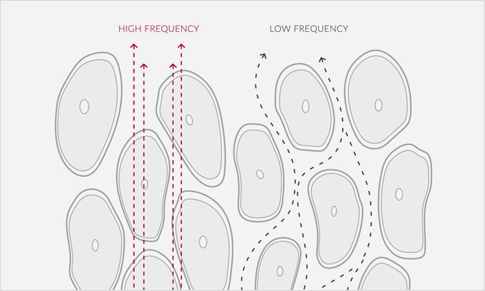 Low frequencies do not pass through the cell membranes, so they mainly reflect extracellular water, while high frequencies pass through the cell membranes and we are able to reflect both extra/ intracellular water. Using these tendencies we use multi-frequencies from low to high frequencies and measure intracellular and extracellular water separately. Through this, we can accurately measure extracellular water, total body water, and intracellular water, and furthermore, check the water balance. As the newest advance to our multi-frequency, we added the world’s first 3MHz High-frequency so that we can ensure an even more stable measurement within the 50~500kHz impedance as these tend to be the major frequencies when analyzing our body composition, and this helps us to stabilize the measurements even when there are interferences from the outside or posture errors. Not only did it enable stability but it also, it enabled us to accurately measure many different patients that have irregular body water status and professional athletes with special body types.
Low frequencies do not pass through the cell membranes, so they mainly reflect extracellular water, while high frequencies pass through the cell membranes and we are able to reflect both extra/ intracellular water. Using these tendencies we use multi-frequencies from low to high frequencies and measure intracellular and extracellular water separately. Through this, we can accurately measure extracellular water, total body water, and intracellular water, and furthermore, check the water balance. As the newest advance to our multi-frequency, we added the world’s first 3MHz High-frequency so that we can ensure an even more stable measurement within the 50~500kHz impedance as these tend to be the major frequencies when analyzing our body composition, and this helps us to stabilize the measurements even when there are interferences from the outside or posture errors. Not only did it enable stability but it also, it enabled us to accurately measure many different patients that have irregular body water status and professional athletes with special body types. -
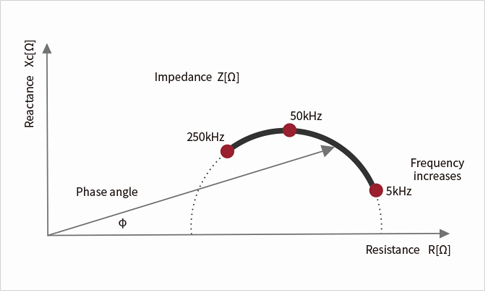 Reactance is a resistance component that occurs in cell membranes and with the reactance we are able to determine the cellular health status. For example, through the reactance data, we are able to know the somatic cell mass, cellular structural integrity, and physiological functional level of the cell. By providing an extended reactance measurement from not only the 50 kHz, but also from 5kHz, and 250kHz, and honing the accuracy in these ranges, InBody is able to provide even more parameters. These parameters can be used in various clinical fields for research purposes to pre-screen undetected diseases, evaluate nutritional status, and also to implement these data into rehabilitation.
Reactance is a resistance component that occurs in cell membranes and with the reactance we are able to determine the cellular health status. For example, through the reactance data, we are able to know the somatic cell mass, cellular structural integrity, and physiological functional level of the cell. By providing an extended reactance measurement from not only the 50 kHz, but also from 5kHz, and 250kHz, and honing the accuracy in these ranges, InBody is able to provide even more parameters. These parameters can be used in various clinical fields for research purposes to pre-screen undetected diseases, evaluate nutritional status, and also to implement these data into rehabilitation. -
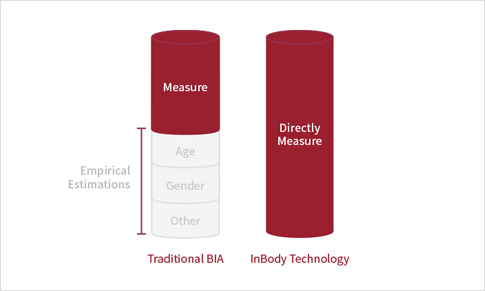 InBody does not use gender or age to determine the body composition. In the past, empirical data was used to increase the accuracy of the body composition result. however the measurements showed poor accuracy depending on the measurement groups. InBody is the first equipment to overcome these limitations with technology, and accurately analyzes body composition without using empirical variables.
InBody does not use gender or age to determine the body composition. In the past, empirical data was used to increase the accuracy of the body composition result. however the measurements showed poor accuracy depending on the measurement groups. InBody is the first equipment to overcome these limitations with technology, and accurately analyzes body composition without using empirical variables. -
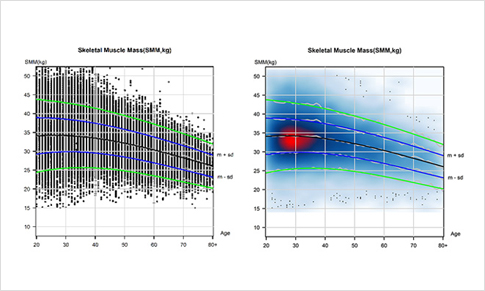 InBody provides Age differentiated graphs for each body composition analysis parameter based on InBody data accumulated from around the world. With InBody’s Big Data, a comprehensive analysis is provided so that you can compare your data to the data of the young age group (T-score) and the same age group (Z-score)
InBody provides Age differentiated graphs for each body composition analysis parameter based on InBody data accumulated from around the world. With InBody’s Big Data, a comprehensive analysis is provided so that you can compare your data to the data of the young age group (T-score) and the same age group (Z-score)
- Interested in learning more about how InBody
can fit into your practice? - InBody devices are used by leading professionals around the
world to give their clients results they can trust and track.



